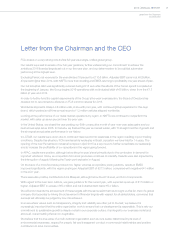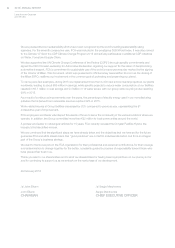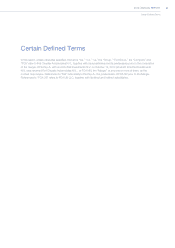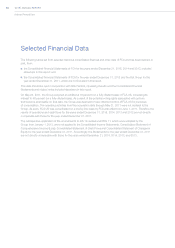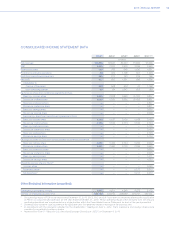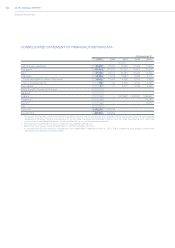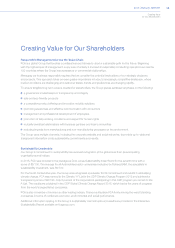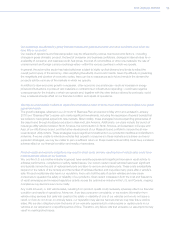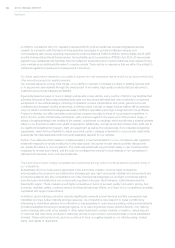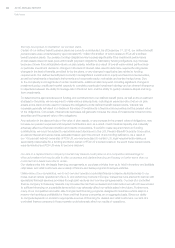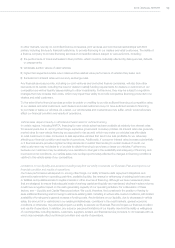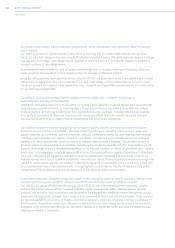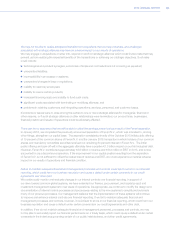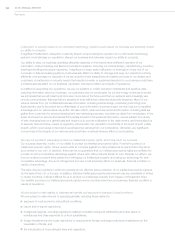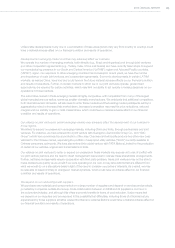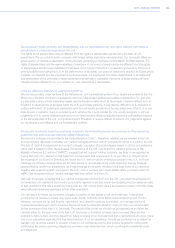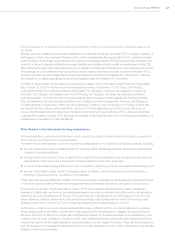Chrysler 2015 Annual Report Download - page 17
Download and view the complete annual report
Please find page 17 of the 2015 Chrysler annual report below. You can navigate through the pages in the report by either clicking on the pages listed below, or by using the keyword search tool below to find specific information within the annual report.
2015 | ANNUAL REPORT 17
In the automotive business, sales to end-customers are cyclical and subject to changes in the general condition of
the economy, the readiness of end-customers to buy and their ability to obtain financing, as well as the possible
introduction of measures by governments to stimulate demand. The automotive industry is also subject to the
constant renewal of product offerings through frequent launches of new models. A negative trend in the automotive
industry or our inability to adapt effectively to external market conditions coupled with more limited capital than many
of our principal competitors could have a material adverse impact on our financial condition and results of operations.
Laws, regulations and governmental policies, including those regarding increased fuel economy requirements and
reduced greenhouse gas emissions, may have a significant effect on how we do business and may adversely affect
our results of operations.
In order to comply with government regulations related to fuel economy and emissions standards, we must devote
significant financial and management resources, as well as vehicle engineering and design attention, to these legal
requirements. We expect the number and scope of these regulatory requirements, along with the costs associated
with compliance, to increase significantly in the future, and these costs could be difficult to pass through to customers.
As a result, we may face limitations on the types of vehicles we produce and sell, and where we can sell them, which
could have a material adverse impact on our financial condition and results of operations.
Government scrutiny has also increased industry-wide, and is expected to remain high, in connection with a recent
significant EPA action involving the tailpipe emissions of a competitor’s diesel vehicles. As a result, original equipment
manufacturers (“OEMs”) will likely experience additional regulation, increased enforcement and a more lengthy
regulatory approval process.
In many cases, technological and cost barriers limit the mass-market potential of sustainable natural gas and electric
vehicles. In certain other cases, the technologies that we plan to employ are not yet commercially practical and depend
on significant future technological advances by us and by suppliers. There can be no assurance that these advances will
occur in a timely or feasible manner, that the funds we have budgeted or expended for these purposes will be adequate,
or that we will be able to obtain rights to use these technologies. Further, our competitors and others are pursuing similar
technologies and other competing technologies, and there can be no assurance that they will not acquire and implement
similar or superior technologies sooner than we will or on an exclusive basis or at a significant price advantage.
Our success largely depends on the ability of our current management team to operate and manage effectively.
Our success largely depends on the ability of our senior executives and other members of management to effectively
manage the Group and individual areas of the business. In particular, our Chief Executive Officer, Sergio Marchionne,
is critical to the execution of our strategic direction and implementation of our Business Plan. Although Mr. Marchionne
has indicated his intention to remain as our Chief Executive Officer through the period of our Business Plan, if we
were to lose his services or those of any of our other senior executives or key employees it could have a material
adverse effect on our business prospects, earnings and financial position. We have developed succession plans
that we believe are appropriate in the circumstances, although it is difficult to predict with any certainty that we will
replace these individuals with persons of equivalent experience and capabilities. If we are unable to find adequate
replacements or to attract, retain and incentivize senior executives, other key employees or new qualified personnel
our business, financial condition and results of operations may suffer.
We may be subject to more intensive competition if other manufacturers pursue consolidations.
We have advocated consolidation in our industry due to our view that the automotive industry is characterized by
significant duplication in product development costs, much of which does not drive value as perceived by consumers.
We believe that sharing product development costs among manufacturers, preferably through consolidation, will
enable automakers to improve their return on capital employed for product development and manufacturing and
enhance utilization of tooling, machinery and equipment. While we continue to implement our Business Plan, and we
believe that our business will continue to grow and our operating margins will continue to improve, if our competitors
are able to successfully integrate with one another and we are not successful with our own efforts to enhance
collaboration or adapt effectively to increased competition, our competitors’ integration could have a material adverse
impact on our financial condition and results of operations.


